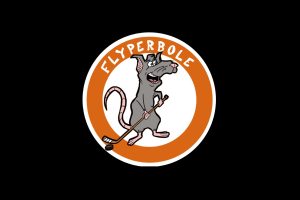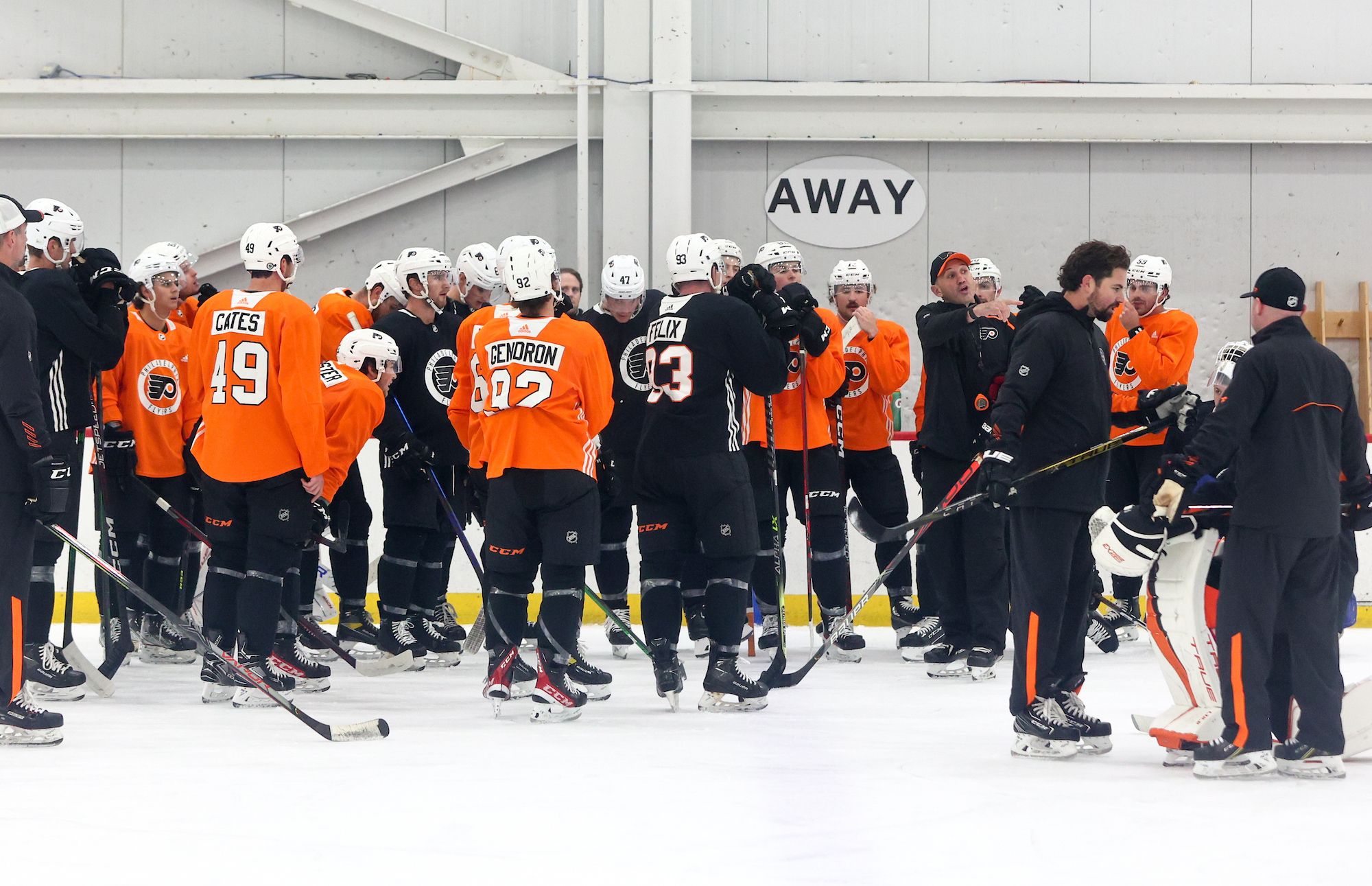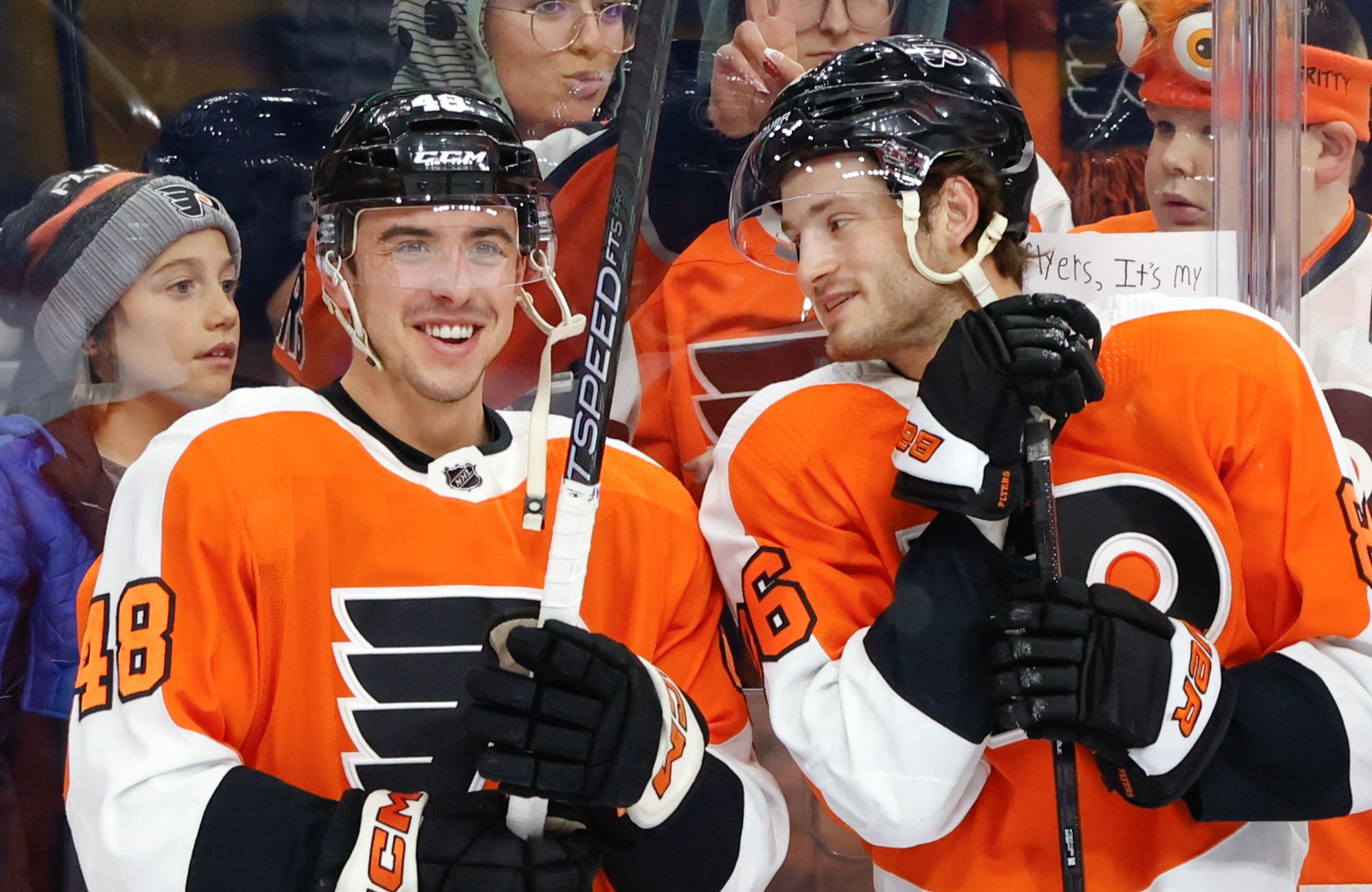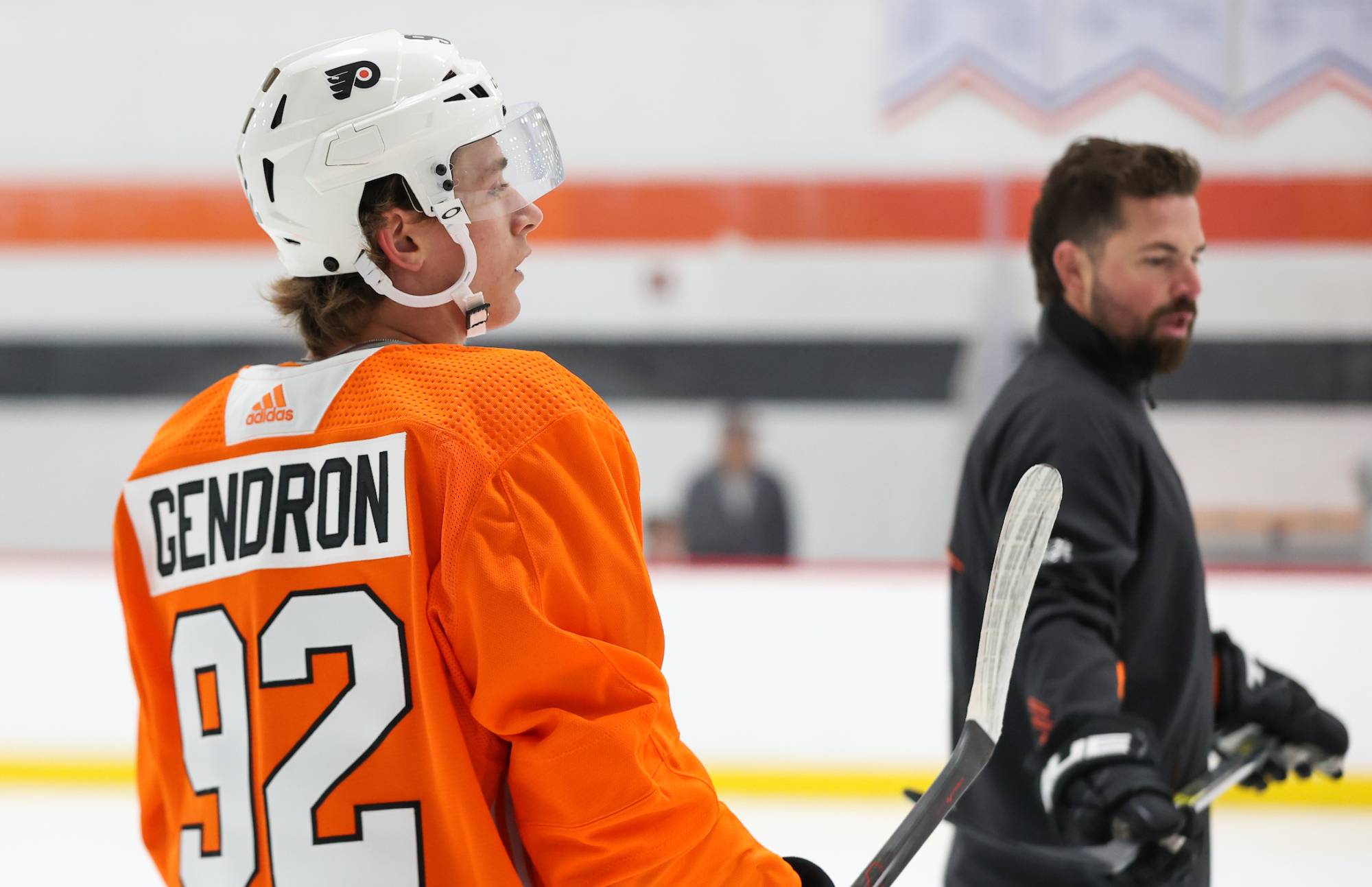For the first time this season, we’re going to look at the Flyers Corsi and Zone Start numbers in their own post. This is something we did in the playoffs after games, but stopped after the Flyers won Game 4 against Boston. Something about winning Game 5 and a lack of time ended the posts.
Here’s a great way of looking at the Fenwick and Corsi, copied from the Game 4 postt:
I’ve said before the two stats are used to show territorial dominance, but here’s a really easy way to think about this information: Both stats are simply a “plus/minus” statistic, exactly like plus/minus except instead of using goals, these two stats use shots. The difference between the two is that Corsi includes blocked shots while Fenwick doesn’t. So when you see Brian Boucher with a +7 Fenwick, it means he was on the ice for 7 more Flyers shots (Goals, Saves, and Missed Shots) than Bruins shots. Corsi is the same, but includes Blocked Shots.
Zone start is a lot easier, as that simply looks at the number of times a player is on the ice for an offensive zone faceoff divided by the total offensive AND defensive zone faceoffs. Something we’ve been tracking this year is non-icing zone starts, which removes those defensive zone draws resulting from an icing. This allows us to see how the coaches are using their players, not just the on-ice play.
Jump for some fun tables.
First, I’d like to thank Quisp from Jewels From the Crown for helping to organize the spreadsheets in Excel. Second, to look at the entire spreadsheet, including game-by-game numbers, sortable by player or game, click here.
Forwards
table { }.font5 { color: windowtext; font-size: 8pt; font-weight: 400; font-style: normal; text-decoration: none; font-family: Verdana; }td { padding-top: 1px; padding-right: 1px; padding-left: 1px; color: windowtext; font-size: 10pt; font-weight: 400; font-style: normal; text-decoration: none; font-family: Verdana; vertical-align: bottom; border: medium none; white-space: nowrap; }.xl24 { text-align: center; }.xl25 { text-align: center; }ruby { }rt { color: windowtext; font-size: 8pt; font-weight: 400; font-style: normal; text-decoration: none; font-family: Verdana; display: none; }
| GF | GA | Fen% | Corsi% | OZ% | NI OZ% | |
| Betts | 9 | 9 | 0.437 | 0.415 | 0.281 | 0.303 |
| Carcillo | 4 | 12 | 0.433 | 0.437 | 0.340 | 0.363 |
| Nodl | 17 | 10 | 0.511 | 0.491 | 0.510 | 0.542 |
| Carter | 29 | 19 | 0.513 | 0.507 | 0.463 | 0.507 |
| Richards | 27 | 22 | 0.506 | 0.493 | 0.491 | 0.537 |
| Hartnell | 40 | 18 | 0.532 | 0.529 | 0.542 | 0.596 |
| van Riemsdyk | 24 | 18 | 0.514 | 0.502 | 0.508 | 0.565 |
| Leino | 41 | 16 | 0.546 | 0.533 | 0.601 | 0.657 |
| Giroux | 25 | 23 | 0.537 | 0.536 | 0.520 | 0.556 |
| Powe | 17 | 17 | 0.501 | 0.491 | 0.420 | 0.463 |
| Shelley | 10 | 5 | 0.440 | 0.417 | 0.336 | 0.390 |
| Briere | 41 | 19 | 0.547 | 0.550 | 0.545 | 0.599 |
| Zherdev | 17 | 12 | 0.538 | 0.535 | 0.507 | 0.551 |
| Wellwood | 2 | 1 | 0.471 | 0.464 | 0.583 | 0.778 |
| TEAM | 102 | 68 | 0.517 | 0.508 | 0.487 | 0.528 |
There’s a lot to take in here, so don’t get overwhelmed. The first two columns are the goals for and against while the player is on the ice. The middle two columns are their Fenwick and Corsi scores, expressed as a percentage. The last two are their zone starts.
So here’s the best way of looking at this. First, look at the two columns on the right. Those frame how you look at the other four columns. What do those two columns on the right tell you? On the far right is those zone starts that coaches have control over. So far, the Flyers have started 52.8% of their coach-eligible faceoffs in the offensive zone. That’s a good starting point.
Those players who start in the offensive zone more than the team shouldn’t surprise you: Eric Wellwood, Ville Leino, Danny Briere, Scott Hartnell, James van Riemsdyk, Claude Giroux, and Nikolay Zherdev.
Where it gets a bit surprising is that Andreas Nodl and Mike Richards join that list, while Jeff Carter doesn’t. This goes back to the story I wrote about how the Flyers were misusing Mike RIchards. Anyway, let’s not get sidetracked with a rant. The Flyers use their fourth line (Powe, Shelley, Carcillo, and Betts) in the defensive zone, which shouldn’t surprise you.
Next, when looking at the Fenwick and Corsi numbers, you look to the zone start column (not the non-icing zone start) to see the situations they were in on the ice. This is important, since players who start in the offensive zone more often are more likely to win the shot battle (Fenwick and Corsi).
table { }.font5 { color: windowtext; font-size: 8pt; font-weight: 400; font-style: normal; text-decoration: none; font-family: Verdana; }td { padding-top: 1px; padding-right: 1px; padding-left: 1px; color: windowtext; font-size: 10pt; font-weight: 400; font-style: normal; text-decoration: none; font-family: Verdana; vertical-align: bottom; border: medium none; white-space: nowrap; }.xl24 { text-align: center; }.xl25 { text-align: center; }ruby { }rt { color: windowtext; font-size: 8pt; font-weight: 400; font-style: normal; text-decoration: none; font-family: Verdana; display: none; }
| Corsi Rank | OZ Rank | |
| Briere | 1 | 3 |
| Giroux | 2 | 5 |
| Zherdev | 3 | 8 |
| Leino | 4 | 1 |
| Hartnell | 5 | 4 |
| Carter | 6 | 10 |
| van Riemsdyk | 7 | 7 |
| Richards | 8 | 9 |
| Powe | 9 | 11 |
| Nodl | 10 | 6 |
| Wellwood | 11 | 2 |
| Carcillo | 12 | 12 |
| Shelley | 13 | 13 |
| Betts | 14 | 14 |
What this shows is the team-rank of each player in each category. So while Betts has a team-worst Corsi, he also has a team-worst zone start. This is part of what Don Cherry missed when going on his anti-Corsi rant. Context is crucial. Betts isn’t a bad player because he has a bad Corsi. He will have a bad Corsi because he has terrible opportunities.
Similarly, van Riemsdyk, Carcillo, and Shelley, have the same rank, so they’re performing as expected. Instead, the players with Corsi scores to look at are Claude Giroux, Nik Zherdev, and Jeff Carter. Those players who are performing worse at controlling the play than they should include Andreas Nodl and Ville Leino.
It is for this reason that, while Danny Briere has a superb Corsi score, it’s less impressive because he should have that score. Claude Giroux is getting first-second-line opportunities, and he’s performing at a first-line rate. Carter is getting 3rd-4th line opportunities, but performing at 2nd-3rd line rates. Similarly, Zherdev is getting third-line opportunities and performing at a 1st-2nd line rate.
Lastly, while the goals for and goals against are listed here, it’s mainly to show the correlation between goals scored, shots fired, and zone starts. Is it any coincidence that Briere is getting opportunities, controlling the play, and seeing the Flyers score goals? No. Similarly, is it any coincidence that Betts is starting in his own zone, giving up tons of shots, and giving up goals? No.
The other aspect of goal scoring is looking at PDO. PDO is a player’s on-ice save percentage plus their on-ice shooting percentage. The number should be roughly 1000 (although the average varies depending on league averages). For example, a 92.3 save percentage added to a 7.9% shooting percentage would result in a 1002 PDO. Head over to behindthenet.ca to see how the Flyers forwards are performing in the luck factor.
But it’s worth noting that the bottom four players in plus/minus (Giroux, Powe, Betts, and Carcillo) are in the bottom-five of PDO. Similarly, the top-six in plus minus (Leino, Briere, Hartnell, Carter, Nodl, and van Riemsdyk) are in the top-eight in PDO. Needless to say, if you see a player with a poor plus/minus, look to their luck. Giroux is a great example.
The team is a plus-34 (by my calculations, anyway) at 5-on-5, but Giroux is only a plus-2. A lot of that has to do with Flyers goaltenders stopping only 91.4% of opponents shots while he’s on the ice, better than only Powe and Carcillo. Seeing as how those goalies are stopping 92.7% of all shots fired at 5-on-5, Giroux is getting unlucky in his own end.
This is a lot of information, and it’s dense information at that. For this reason, I’ll spare you the defensemen numbers for now, but they’ll be up before the Flyers take on the Sabres on Tuesday, don’t worry.









